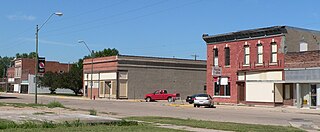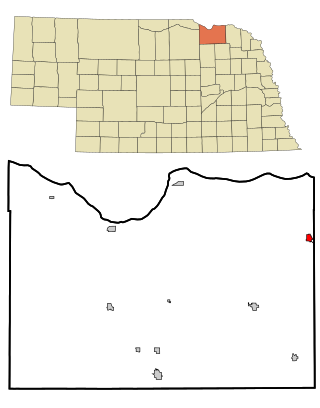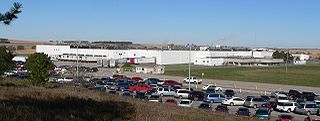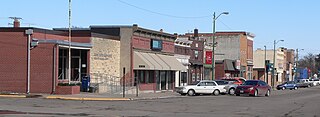
Howard County is a county in the state of Nebraska. As of the 2020 United States Census, the population was 6,475. Its county seat is St. Paul. The county was formed in 1871 and named after Civil War General Oliver Otis Howard.

Elgin is a city in Antelope County, Nebraska, United States. The population was 661 at the 2010 census.

Oakland is a city in Burt County, Nebraska, United States. The population was 1,244 at the 2010 census. Oakland continues to build on its strong foundation with its bi-annual Swedish Festival and is known by its proclamation from the Swedish Consul-General and the Governor of Nebraska as the "Swedish Capital of Nebraska." Oakland is also known as one of the more socially accepting towns in Nebraska. Each year, drag queens come from far and wide to showcase their culture at the Burt County Fair.

Tekamah is a city in Burt County, Nebraska, United States. The population was 1,736 at the 2010 census. It is the county seat of Burt County.

Abie is a village in Butler County, Nebraska, United States. The population was 69 at the 2010 census.

Obert is a village in Cedar County, Nebraska, United States. The population was 23 at the 2020 census.

Harvard is a city in Clay County, Nebraska, United States. As of the 2010 census, the city population was 1,013. It is part of the Hastings micropolitan area.

Maskell is a village in Dixon County, Nebraska, United States. It is part of the Sioux City, IA–NE–SD Metropolitan Statistical Area. The population was 76 at the 2010 census. It is reportedly home to the smallest city hall in the United States.

Howard City, locally referred to as Boelus, is a village in Howard County, Nebraska, United States. The population was 189 at the 2010 census. It is part of the Grand Island, Nebraska Micropolitan Statistical Area.

Crofton is a city in Knox County, Nebraska, United States. The population was 726 at the 2010 census.

Madison is a city in and the county seat of Madison County, Nebraska, United States. The population was 2,283 at the 2020 census.

Bassett is a city in Rock County, Nebraska, United States. The population was 619 at the 2010 census. It is the county seat of Rock County.

Morse Bluff is a village in Saunders County, Nebraska, United States. The population was 117 at the 2020 census.

Stanton is a city in Stanton County, Nebraska, United States. The population was 1,577 at the 2010 census. It is the county seat of Stanton County. Stanton was platted in 1870. Both the city and county are named after Edwin Stanton, secretary of war for president Abraham Lincoln during the American Civil War.

Kennard is a village in Washington County, Nebraska, United States. The population was 361 at the 2010 census.

Washington is a village in Washington County, Nebraska, United States. The population was 150 at the 2010 census.

Wayne is a city in Wayne County, Nebraska, United States. The population was 5,660 at the 2010 census. It is the county seat of Wayne County and the home of Wayne State College.

Winside is a village in Wayne County, Nebraska, United States. The population was 381 at the 2020 census.

York is a city in and the county seat of York County, Nebraska, United States. At the 2010 census, the city population was 7,766. It is the home of York University and the Nebraska Correctional Center for Women.

Wakefield is a city in Dixon and Wayne Counties in the State of Nebraska. The population was 1,451 at the 2010 census.























